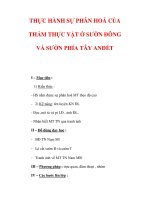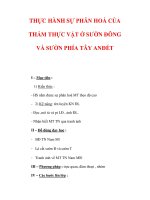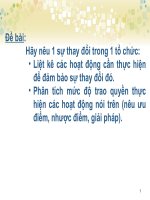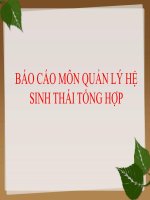MÔN QUẢN LÝ THẢM THỰC VẬT: artificial regeneration 2
Bạn đang xem bản rút gọn của tài liệu. Xem và tải ngay bản đầy đủ của tài liệu tại đây (3.2 MB, 20 trang )
After two growing seasons in the field
Transplanted seedling
Direct-seed
1
Two types…
Bare-rooted seedling
Containerized seedling
2
Containerized Seedlings
Moved to the field in the soil that they were grown. Planted with the soil still attached to the roots
3
Bare Root Seedlings
Roots separated from the soil in which they were grown before
they are planted
Survival depends on quick re-establishment of functional contact
between the roots and the soil
4
Bare root Vs. Containerized
Containerized: Extended planting season, better control of germination/growing conditions, shorter nursery
rotations, uniformity of size/condition, undisturbed roots, protection of roots
Bare-root: cheap to produce, low bulk, easier to transport & handle
in field
Differ from temperate regions, There is no winter resting
period in tropical countries so bare root seedling rarely
survive and mainly container plants are produced
5
Containerized seedling
Seed collection
Seed storage
Pre-treatment of seeds
Sowing the seed
Container preparing
Transplanting germinated seedlings
Tending
Quality of mother trees; timing
o
Low moisture (4-12%); low temp. (<5 C); Dark room
Chemical; mechanical; boiled water
Method (strip/ row/ spot); timing; density
Size; material (soil, fertilize, nutrition)
Techniques
Watering; covering; fertilizing
6
Planting technique
7
Container size
7 x 12 cm
9 x 13 cm
10 x 15 cm
13 x 18 cm
8
Quantity of sowing seeds
The number of sowing seeds (X) can be calculated as follows
NP. 10
X=
ER
Whereas
2
X (gr): Quantity of sowing seeds/m or m
2
N: The number of reasonable seedling/m or m
P (gr): The weight of 1.000 seeds
E (%): Germinate rate
R (%): Pure rate (Plump seeds/total number of seeds)
9
Quantity of seedlings
10
Seedling Size
Caliper-diameter
at root collar (most common
measure of seedling size)
Height
11
Seedling Size
Best indicator of seedling’s chances of survival
Relative growth
rate
Size relative to
competitors
Resistance to damage
The less dense you plant seedlings the bigger they will be in a given period of time
12
Planting
Transplanting of bare rooted seedlings is rarely done in the tropics, common practice in temperate regions
Transplanting of contained seedlings is the standard method in the tropics.
13
Planting
Planted seedlings will grow faster initially than seedlings from seed
With planting, wood yields are generally better than with seeded stands
Initial costs may be higher than for natural regeneration and direct seeding
14
Hole size
30 x 30 x 30
40 x 40 x 40
50 x 50 x 50
The most common and proven technique is the
planting hole method
15
Planting stock (density)
Big hard wood trees
1.660/ 2.500/ 3.300
Mangletia conifera
Pinus sp.
Canarium album
Chukrasia tabularis
…
Sawed wood (small wood)
2.200/ 2.500/ 3.300/ 4.500
Acasia sp.
Eucalyptus sp.
Melia azedarach
Styrax tonkinensis
…
16
Square vs. Triangle
17
Field planting
18
Tending after planting
Weeding
Fertilization
Protecting from animals
Replanted: failures below 10% are generally not replanted because of the high costs
19
Assessing
To assess the success of your regeneration efforts, it is
necessary to check survival of the seedlings.
One year after planting, seeding, or natural regeneration
has occurred, is a good time for assessment.
A
number of plots should be taken over the entire
planting site to get an idea of success over the entire site.
r ~ 5,67 m
Plot area = 100m2
Assessing area = 5-10% total area
20









